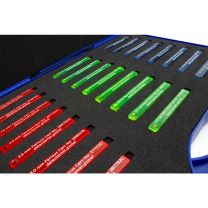X-Ray Visible Test Pieces
X-ray inspection systems are another critical technology in the food industry for ensuring product safety and quality. Like metal detectors, these systems require calibration to maintain their accuracy and effectiveness in detecting contaminants. X-ray inspection systems offer advanced capabilities for detecting a wide range of contaminants, not just metals. These systems can identify non-metallic contaminants like glass, plastic, rubber, bone, and more, providing a broader scope of safety assurance. X-ray inspection is also used for quality control, detecting product defects, checking fill levels, and ensuring package integrity. Click to read more...
Why Calibration Is Important for X-ray Inspection:
- Accuracy and Sensitivity: Calibration ensures that the x-ray system maintains high sensitivity and accuracy. This is crucial because the system must distinguish between contaminants and legitimate variations in product density.
- Consistency Across Product Types: In food production, different products may have different densities, shapes, and packaging materials. Calibration allows the x-ray system to adjust to these variations, ensuring consistent performance.
- Changes in Operating Conditions: Like metal detectors, x-ray systems can be influenced by environmental factors such as temperature, humidity, and electromagnetic interference. Calibration helps maintain accurate operation under varying conditions.
- Compliance with Regulations and Standards: The food industry is subject to strict regulations and standards, including those governing product safety and contamination. Regular calibration ensures that x-ray systems meet these requirements, helping companies avoid fines, recalls, or other legal issues.
- Reducing False Positives and Negatives: Proper calibration minimizes false positives (incorrectly identifying a contaminant) and false negatives (failing to detect a contaminant). This is critical to avoid unnecessary production interruptions or contaminated products reaching consumers.
- Quality Assurance and Safety: Calibration supports quality assurance by ensuring the system accurately identifies contaminants and defects. This contributes to consumer safety and helps maintain a company's reputation for delivering safe, high-quality products.
- Equipment Maintenance and Longevity: Calibration helps ensure that the x-ray system is functioning optimally, reducing wear and tear and extending the equipment's lifespan. It can also identify issues early, preventing costly breakdowns or malfunctions.
- Documentation and Auditability: Calibration provides a record of system performance over time, which is valuable for audits and inspections. It demonstrates a commitment to food safety and adherence to best practices.
Calibration is crucial for both metal detectors and x-ray inspection systems in the food industry. It ensures accuracy, consistency, compliance with regulations, and consumer safety, while also supporting quality assurance and equipment longevity. By calibrating these systems regularly, food companies can maintain high safety and quality standards, ultimately benefiting both the industry and consumers.
X-ray inspection systems are another critical technology in the food industry for ensuring product safety and quality. Like metal detectors, these systems require calibration to maintain their accuracy and effectiveness in detecting contaminants. X-ray inspection systems offer advanced capabilities for detecting a wide range of contaminants, not just metals. These systems can identify non-metallic contaminants like glass, plastic, rubber, bone, and more, providing a broader scope of safety assurance. X-ray inspection is also used for quality control, detecting product defects, checking fill levels, and ensuring package integrity.
Why Calibration Is Important for X-ray Inspection:
- Accuracy and Sensitivity: Calibration ensures that the x-ray system maintains high sensitivity and accuracy. This is crucial because the system must distinguish between contaminants and legitimate variations in product density.
- Consistency Across Product Types: In food production, different products may have different densities, shapes, and packaging materials. Calibration allows the x-ray system to adjust to these variations, ensuring consistent performance.
- Changes in Operating Conditions: Like metal detectors, x-ray systems can be influenced by environmental factors such as temperature, humidity, and electromagnetic interference. Calibration helps maintain accurate operation under varying conditions.
- Compliance with Regulations and Standards: The food industry is subject to strict regulations and standards, including those governing product safety and contamination. Regular calibration ensures that x-ray systems meet these requirements, helping companies avoid fines, recalls, or other legal issues.
- Reducing False Positives and Negatives: Proper calibration minimizes false positives (incorrectly identifying a contaminant) and false negatives (failing to detect a contaminant). This is critical to avoid unnecessary production interruptions or contaminated products reaching consumers.
- Quality Assurance and Safety: Calibration supports quality assurance by ensuring the system accurately identifies contaminants and defects. This contributes to consumer safety and helps maintain a company's reputation for delivering safe, high-quality products.
- Equipment Maintenance and Longevity: Calibration helps ensure that the x-ray system is functioning optimally, reducing wear and tear and extending the equipment's lifespan. It can also identify issues early, preventing costly breakdowns or malfunctions.
- Documentation and Auditability: Calibration provides a record of system performance over time, which is valuable for audits and inspections. It demonstrates a commitment to food safety and adherence to best practices.
Calibration is crucial for both metal detectors and x-ray inspection systems in the food industry. It ensures accuracy, consistency, compliance with regulations, and consumer safety, while also supporting quality assurance and equipment longevity. By calibrating these systems regularly, food companies can maintain high safety and quality standards, ultimately benefiting both the industry and consumers.
 Detectamet Australia (English - $ AUD ) Click here to change your currency, region and language.
Detectamet Australia (English - $ AUD ) Click here to change your currency, region and language.












